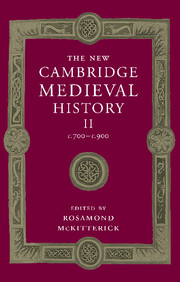Book contents
- Frontmatter
- PART I POLITICAL DEVELOPMENT
- PART II GOVERNMENT AND INSTITUTIONS
- 15 Kingship and royal government
- 16 The aristocracy
- 17 Social and military institutions
- 18 Economic Organisation
- 19 Rural society in Carolingian Europe
- 20 Money and coinage
- PART III CHURCH AND SOCIETY
- PART IV CULTURE AND INTELLECTUAL DEVELOPMENTS
- Conclusion
- Appendix genealogical tables
- List of primary sources
- Bibliography of secondary works arranged by chapter
- Index of manuscripts
- General index
- Frontispiece">
- Plate section
- Map 4 Charlemagne’s Europe and Byzantium, 814
- Map 19 The ecclesiastical provinces of western Europe 700-900
- Map 20 Carolingian schools, scriptoria and literary centres
- Genealogical table X: Wessex
- References
20 - Money and coinage
from PART II - GOVERNMENT AND INSTITUTIONS
Published online by Cambridge University Press: 28 March 2008
- Frontmatter
- PART I POLITICAL DEVELOPMENT
- PART II GOVERNMENT AND INSTITUTIONS
- 15 Kingship and royal government
- 16 The aristocracy
- 17 Social and military institutions
- 18 Economic Organisation
- 19 Rural society in Carolingian Europe
- 20 Money and coinage
- PART III CHURCH AND SOCIETY
- PART IV CULTURE AND INTELLECTUAL DEVELOPMENTS
- Conclusion
- Appendix genealogical tables
- List of primary sources
- Bibliography of secondary works arranged by chapter
- Index of manuscripts
- General index
- Frontispiece">
- Plate section
- Map 4 Charlemagne’s Europe and Byzantium, 814
- Map 19 The ecclesiastical provinces of western Europe 700-900
- Map 20 Carolingian schools, scriptoria and literary centres
- Genealogical table X: Wessex
- References
Summary
changes in coinage and monetary circulation in Europe were as radical as the political developments they accompanied during the eighth and ninth centuries. The period saw the virtual extinction of gold coinages and their replacement with silver in almost all areas of Europe. The new silver denomination, the penny, introduced in Francia and England towards the end of the seventh century, subsequently took on a broader, thinner appearance and in this form it became the standard currency unit of medieval Europe, marking the final break with the monetary system of late antiquity. In the Frankish and Anglo-Saxon kingdoms the currency developed a fiscal role in addition to its important commercial function, accompanied by tightening royal control, although by the end of the ninth century in Francia the first signs of feudal usurpation of minting rights can be detected. Elsewhere, the impact of the Muslim conquests of Spain and Sicily were to change their entire monetary systems. In Germany, the use of coin became established in the Rhineland and Bavaria, but to other parts it scarcely penetrated. Further east and north, in eastern and central Europe and in Scandinavia, silver dirhems from the Near East began to arrive in enormous quantities. Yet at just this time there are signs of a possible shortage of silver for currency in western Europe resulting in widespread debasement and perhaps a contraction in the amount of coinage in circulation.
- Type
- Chapter
- Information
- The New Cambridge Medieval History , pp. 538 - 560Publisher: Cambridge University PressPrint publication year: 1995
References
- 4
- Cited by

